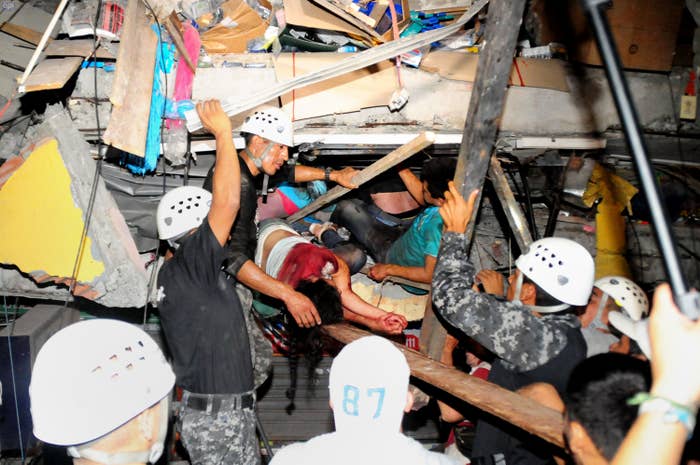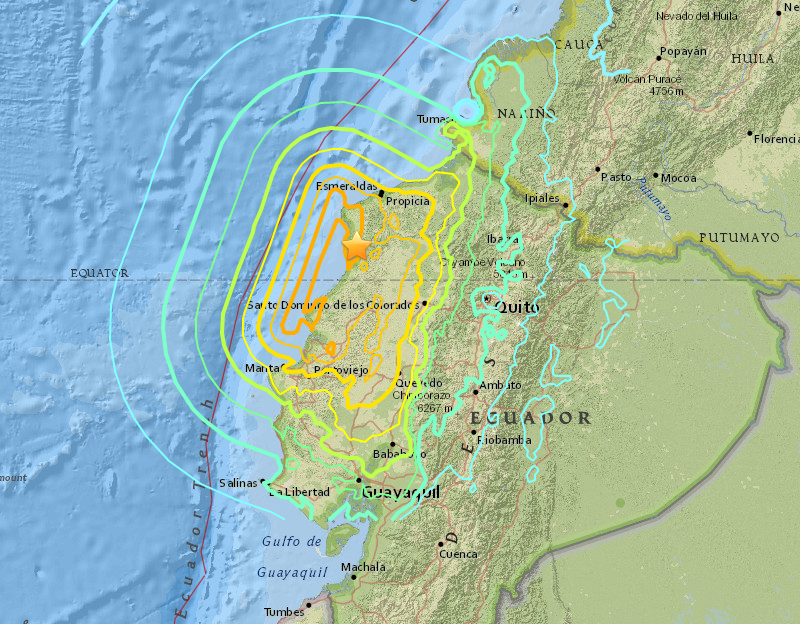
The death toll in the magnitude-7.8 earthquake that struck the coast of Ecuador over the weekend rose to at least 570 people Wednesday as authorities worked to identity the dead.
More than 4,000 people were injured after the earthquake struck near the town of Muisne on Saturday, prompting a state of emergency across six provinces.
Ecuador's attorney general announced Wednesday a total of 570 deaths had been confirmed, including 44 people who had yet to be identified.
The coastal cities of Manta and Pedernales were the hardest hit by the strong quake, which suffered more than 170 deaths each.
In Portoviejo, located about 23 miles inland from Manta, 118 people were also reported dead.
ACTUALIZACIÓN de lista de personas fallecidas a causa del terremoto, corte 20/ABR/2016 16h00 https://t.co/ogv1es02ds
The powerful temblor, the worst experienced by the country in decades, struck near the town of Muisne, roughly 250 miles from Quito, Ecuador's capital, according to the U.S. Geological Survey.
In the hours after the quake, Ecuador's Vice President Jorge Glas initially put the death toll at 77. But by Wednesday morning, that number had risen past 500, with authorities warning it could increase again.
Deputy Interior Minister Diego Fuentes said as many as 2,000 people had been reported missing since the disaster, and officials said the number still missing was between 231 and 1,700.
The Spanish Red Cross told the Associated Press on Monday that as many as 70,000 people may be in need of help, as international aid began arriving in the country and attention turned to helping the survivors.

A magnitude-4.8 foreshock also struck in the same region Saturday. The 7.8-quake was then followed by 250 aftershocks, ranging from 3.5 to 6.1, and striking at a shallower depth, according to the country's Geophysics Institute. On Wednesday, a 6.1 quake off the country's coast prompted fears of more damage, but there appeared to have been no reported damage.
Meanwhile, Ecuador's Risk Management agency said that 10,000 armed forces were deployed to help survivors.
About 3,500 national police were also been sent to the towns of Manabí, Esmeraldas, and Guayas y Santa Elena, and 500 firefighters to Manabí and Pedernales.
Five shelters were set up for those evacuated from their homes, the Associated Press reported.

After the quake, President Rafael Correa — who was in Italy but declared a state of emergency en route to Ecuador — called on his people to have courage, saying authorities were evaluating the damage.
...puestos de control evaluando daños y tomando acciones. Vicepresidente en ECU911 coordinando a nivel nacional. Estoy siguiendo eventos.
"Our grief is very large, the tragedy is very large, but we'll find the way to move forward," he told the Associated Press. "If our pain is immense, still larger is the spirt of our people."
"The Ecuadorean spirit knows how to move forward, and will know how to overcome these very difficult moments."
Gabriel Alcivar — the mayor of Pedernales, a town of 40,000 near the epicenter — told the Associated Press that there was widespread damage and pleaded for rescuers.
"This wasn't just a house that collapsed, it was an entire town," he said.
Colapso de vivienda en Ayacucho y Gómez Rendón. #sismo #Ecuador
The quake was the largest experienced by the country since 1979. Troops were being ferried north using helicopters and buses, but their progress has been hampered by landslides.
In Quito, Ecuador's capital, people felt shaking for about 40 seconds, the Associated Press reported.
Portoviejo, the provincial capital of Manabí, and the resort town Pedernales, appear to have suffered the worst damage. Approximately 270 buildings collapsed in the towns, the New York Times reported, and more than 100 people have died in Portoviejo, AP said.
"It looks like a war zone," 34-year-old florist Viviana Baquezea told the newspaper from the devastated city.
The national police warned people to avoid pedestrian bridges that may have cracked in the shaking.
Images from the region showed a fallen bridge and a crushed car in the port city of Guayaquil, about 260 miles south of Quito.
Se reporta auto aplastado en #Guayaquil por caída de puente en la Av. De Las Américas. Foto cortesía @mercurioec
Images also showed what appeared to be damage to different commercial buildings, roads, and other infrastructure.
Así luce un supermercado tras el #sismo en Ecuador.
Daños en Centro Comercial San Marino por fuerte sismo. #sismo
The quake reportedly caused a power outage in Quito and was felt in numerous surrounding communities. By Monday, the vice president reported power had been restored to some areas.
Zoila Villena, a resident of Quito, told the AP he was "in a state of panic."
"My building moved a lot and things fell to the floor. Lots of neighbors were screaming and kids crying," Villena said.
Alcalde de #Manta informa de graves daños en infraestructuras https://t.co/XsWZT1H4nI
Footage from Guayaquil also showed power outages and people taking refuge outside of buildings.
Sin electricidad en ciudadela en Samborondón. Habitantes se resguardan a la espera de que la situación se normalice.
The state of emergency declarations prompted the country's soccer officials to cancel a championship game.
Glas also announced that Ecuadorian state police and military troops were being activated to protect public order.
According to local reports, the quake also caused damage to the airport in Guayaquil, forcing it to close down.
#URGENTE: El aeropuerto de #Guayaquil suspende sus operaciones tras daños en su infraestructura por sismo de esta noche | @AlertaNews24
The Pacific Tsunami Warning Center warned of hazardous waves after the quake. Correa said that there was no evidence of a tsunami, but both he and Ecuador's Navy advised people to avoid the coast as a precaution.
The chaos in Ecuador came as Japan was still grappling with the aftermath of two quakes, a magnitude-6.2 and 7.0 respectively, that killed dozens. Those temblors struck on Thursday and Saturday, killing 41 people and prompting widespread damage in the southern part of the country.
Though both Japan and Ecuador are both situated on what is sometimes called the "Ring of Fire" — a seismically active zone surrounding the Pacific Ocean — the quakes in the two countries are not believed to have been connected.


